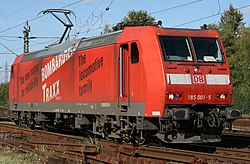TRAXX

Bombardier TRAXX Last Mile
|
|||||||||||||||||||||||
|
|||||||||||||||||||||||
|
|||||||||||||||||||||||
|
|||||||||||||||||||||||
|
|||||||||||||||||||||||
| Type and origin | |
|---|---|
| Power type | Electric |
| Builder | Bombardier Transportation |
| Model | TRAXX F140 AC TRAXX P140 AC TRAXX P160 AC TRAXX F140 AC2 TRAXX F140 MS TRAXX F140 DE |
| Build date | 1996–present |
| Total produced | 1,800 as of 2015[update] |
| Specifications | |
|---|---|
| AAR wheel arr. | B-B |
| UIC class | Bo'Bo' |
| Gauge |
1,435 mm (4 ft 8 1⁄2 in) standard gauge, 1,668 mm (5 ft 5 21⁄32 in) (Spain and Portugal) |
| Length | 18,900 mm (62 ft 1⁄8 in) |
| Width | 2,980 mm (9 ft 9 3⁄8 in) |
| Loco weight | 80–85 t (79–84 long tons; 88–94 short tons) (84–88 t or 83–87 long tons or 93–97 short tons) |
| Electric system(s) | AC, MS: 15 kV/16.7 Hz, 25 kV/50 Hz AC DC, MS: 1.5 kV, 3 kV DC DE: - Catenary |
| Current collection | Pantograph |
| Train brakes | Knorr brake (Disc brake), electric brakes |
| Safety systems |
ETCS ready Various European systems |
| Performance figures | |
|---|---|
| Maximum speed | 140 km/h (87 mph) (freight versions), 160 km/h (99 mph) (passenger versions), 200 km/h (124 mph) version also available |
| Power output | Electric: 5.6 MW (7,500 hp) (1.5 kV: 4.0 MW (5,400 hp)) Diesel: 2.2 MW (3,000 hp) |
| Tractive effort | 270–300 kN (61,000–67,000 lbf) |
| Career | |
|---|---|
| Locale | Europe |

TRAXX F140 AC, DB Class 185
|
|||||||||
|
|||||||||
|
|||||||||
|
|||||||||
|
|||||||||
| Type and origin | |
|---|---|
| Power type | Electric |
| Build date | F140 AC / P160 AC : 1999-January 2006 TRAXX F140 AC2 / P160 AC2 : |
| Total produced | F140 AC1: 312 P140 AC1: 20 P160 AC1: 42 Total: 377 F140 AC2 : 300+ P160 AC2 : 68 Grand Total : 745+ |
| Specifications | |
|---|---|
| Loco weight | 84 t (83 long tons; 93 short tons) (82 t or 81 long tons or 90 short tons) |
| Electric system(s) |
15 kV 16⅔ Hz AC, 25 kV/50 Hz AC Catenary |
| Current collection | Pantograph |
| Performance figures | |
|---|---|
| Maximum speed | F140 AC / F 140 AC2 : 140 km/h (87 mph) P160 AC : 160 km/h (99 mph) P140 AC (for CFL) : 140 km/h (87 mph) |
| Tractive effort | 300 kN (67,000 lbf) |
| Career | |
|---|---|
| Power class | 5.6 MW (7,500 hp) |
Bombardier TRAXX is a modular product platform of electric and Diesel-electric mainline locomotives built by Bombardier Transportation, built in both freight and passenger variants. The first version was a dual voltage AC locomotive built from 2000 for German railways; later versions include DC versions, as well as quadruple voltage machines, able to operate on most European electrification schemes: 1.5/3.0 kV DC and 15/25 kV AC. The family was expanded to include diesel powered versions in 2006. Elements common to all variants include the steel bodyshells, the two bogies with two powered axles each, the three-phase asynchronous induction motors, the cooling exhausts on the roof edges, and the wheel disc brakes.
The TRAXX brand name itself was introduced in 2003. The acronym stands for Transnational Railway Applications with eXtreme fleXibility. Locomotives were primarily made for the railways of Germany, with orders coming from other countries including France, Israel, Switzerland, Sweden, Norway, Italy, Belgium, Luxembourg, Poland, Spain, Hungary, South Africa and The Netherlands.
In the early 1990s, West German federal railway Deutsche Bundesbahn (DB) sought to replace its ageing electric locomotive fleet with a single type. In the previous decade, DB introduced its first universal locomotives with three-phase asynchronous induction motors and two bogies with two powered axles each, the DB Class 120, which had been successful. In 1991, DB requested bids for about 1000 more universal locomotives with an improved design and increased power, the planned DB Class 121. The railway industry began developing new locomotives, but in October 1992, DB cancelled the tender due to the high price of the offers and the changed situation. In 1994, Deutsche Bundesbahn merged with the former East German Deutsche Reichsbahn, creating Deutsche Bahn, bringing over 600 modern DR Class 243 locomotives into the joint locomotive fleet. In addition, the merger coincided with a railway reform, dividing the rolling stock of Deutsche Bahn between its regional passenger, long-distance passenger and freight business areas, making the universal locomotive plans obsolete. From late 1993, the business areas of Deutsche Bahn and their predecessors called new bids for electric locomotives tailored for their specific needs.
...
Wikipedia
